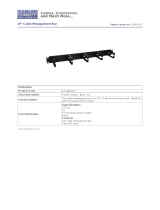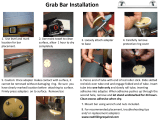
Issue 7, May 2013
Page 3 of 15
Separately Orderable Modules and Panels
InstaPATCH 360 UHD LazrSPEED
®
InstaPATCH 360 UHD TeraSPEED
®
UHD distribution adapter panel, 24xMPO
UHD pass-thru panel, 48xLC LazrSPEED adapters
UHD pass-thru panel, 48xLC TeraSPEED (SM) adapters
Accessories
Fiber cord management sleeve
Related Components for the 3603D-1U-UP
Contact your SYSTIMAX
sales representatives for more information on a wide variety of trunk cables and
accessories that are compatible with these shelves.
Please note that some portions of the instructions will already be completed on preloaded shelf
assemblies.
Precautions
• InstaPATCH 360 modules contain fiber optic cable and passive optical components. When removed from
protective packing, they should be handled carefully and installed in appropriate racks for mechanical
support and protection.
• InstaPATCH 360 modules require virtually no maintenance to maintain their performance. They contain no
user-serviceable components, and any damage to the anti-tamper label or removal of top cover or front
adapter mounting panel will void the warranty.
• Fiber optic cable and jumper performance is sensitive to bending, pulling, and crushing. Minimum bend
radius must be maintained during installation per the manufacturer’s specification. Appropriate pulling grips
must be used during installation, and pulling forces shall not exceed manufacturer’s recommendations. Use
caution to avoid kinking cables.
•
Care should be taken not to compromise the stability of the rack by installation of this equipment.
•
To be installed in restricted access areas only.
Cautions
• Shelves preloaded with modules or panels require two persons to install to rack or cabinet.
• Isopropyl alcohol is flammable, and can cause eye irritation on contact. If eye contact occurs, flush with
water for at least 15 minutes. In case of ingestion, consult a physician. Use only in well ventilated areas
• Disconnected optical components may emit invisible optical radiation that can damage your eyes. Never
look directly into an optical component that may have a laser coupled to it. Serious and permanent retinal
damage is possible. If accidental exposure to laser radiation is suspected, consult a physician for an eye
examination.
• Wearing safety glasses during installation of this shelf is recommended. Although standard safety glasses
provide no protection from potential optical radiation, they offer protection from accidental airborne hardware
and cleaning solvents.
















